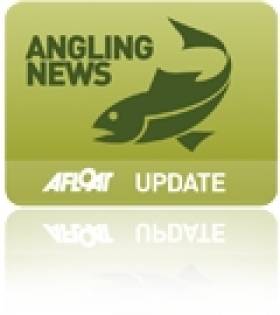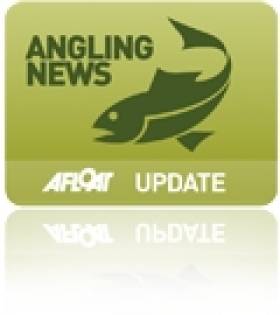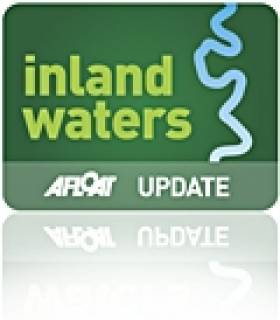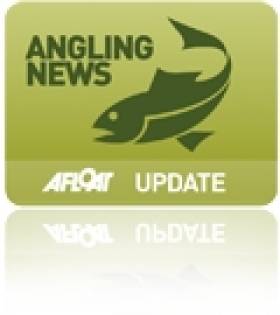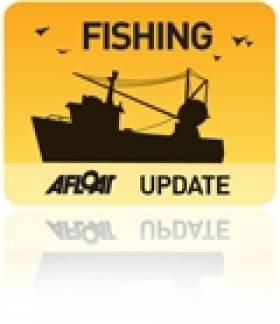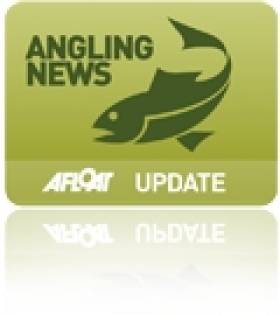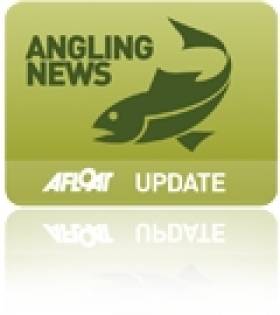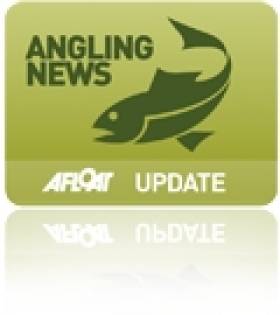Displaying items by tag: Inland Fisheries Ireland
#Angling - Inland Fisheries Ireland (IFI) recently welcomed a visit from Dr Jed Wright of the US Fish and Wildlife Service, who is an expert in habitat assessment, protection and restoration programmes for Atlantic salmon in the Gulf of Maine.
During this visit, Dr Wright spent a day viewing weirs on the Rivers Nore and Slaney and was impressed by the "innovative" fish passage techniques used to support fish migration efforts over a number of these structures.
Following this, Dr Wright gave two informal talks dealing with riverine habitat restoration and barriers assessment in Maine.
Dr Cathal Gallagher, head of research and development with Inland Fisheries Ireland, said IFI "welcomed this important opportunity to share expertise in riverine and habitat restoration techniques.
"It is important that Ireland shares expertise in dealing with complex and difficult issues associated with restoration of damaged rivers and habitat. This is of particular importance when addressing Ireland’s commitments under the Water Framework Directive.”
Minister Launches €240K Funding For Fisheries Development
#Angling - The 2015 Salmon Conservation Fund (SCF) and Midland Fisheries Fund (MFF) are now open for applications, Minister Joe McHugh has announced yesterday (Wednesday 15 April).
In total, €240,000 is available to conserve and develop the inland fisheries resource from funds generated through the sale of salmon licences and Midland Fisheries Area permits.
The schemes administered by Inland Fisheries Ireland (IF) will facilitate clubs, fishery owners, commercial salmon fishers and other organisations to undertake works to improve habitat, stocks, access, invasive species management and angling, under the supervision and direction of IFI.
The works undertaken are important in maintaining and improving capacity within the inland fisheries resource, which is estimated to contribute €755 million annually to the Irish economy.
Announcing the schemes, Minister McHugh said: “I am pleased to be able to support IFI in making these funds available to fisheries interests to allow for ground-up, managed sustainable development of the inland fisheries resources.
"Some wonderful projects have been supported since these funds have been established and I encourage all those interested in fisheries to investigate the possibilities under the various schemes to conserve, develop and promote their local fisheries.”
The Salmon Conservation Scheme has been in existence for eight years and has allocated funding to 184 salmon projects all around Ireland. €200,000 is available for distribution under this scheme in 2015.
The Midland Fisheries Fund, which is now beginning its third year, has seen 17 projects undertaken in the midlands area developing angling resources, supporting scientific research and conserving fisheries habitat. A further €40,000 is available under this scheme for 2015.
Full details and application forms are available on the Midland Fisheries Fund HERE.
Inland Fisheries Ireland Board Members Appointed
#inlandfisheries - Minister of State at the Department of Communications, Energy and Natural Resources, Joe McHugh TD, announced today that the Government had noted the decision to appoint Dr Frances Lucy to the Board of Inland Fisheries Ireland for a period of five years. This appointment was made having regard to advice received from the Joint Oireachtas Committee (JOC) on Transport and Communications in accordance with Sections 12 (1) (b) and 12 (3) of the Inland Fisheries Act, 2010.
In welcoming the appointment of Dr Lucy, Minister of State McHugh said "Dr Lucy brings a wealth of experience and expertise to the Board of Inland Fisheries Ireland, particularly in the areas of fisheries conservation and aquatic invasive species research. I wish Dr Lucy well in her role as a board member"
This appointment will mean that all ten Inland Fisheries Ireland board positions are now filled.
Dr Frances Lucy is a lecturer in Environmental Science in the Institute of Technology, Sligo (1992 to present), lecturing on water quality, freshwater ecology, invasive species, fisheries management and conservation management. Dr Lucy previously served on the Board of Inland Fisheries Ireland from 1 July 2010 to 30 June 2013.
Inland Fisheries Ireland Board Members at 24 March 2015
|
IFI Board Members |
Appointment Date |
Expiry Date |
|
Brendan O’Mahony (Chairperson) |
1 July 2010 |
30 June 2015 |
|
Lal Faherty |
1 July 2010 |
30 June 2015 |
|
John Geary |
3 November 2010 |
2 November 2015 |
|
Marcus MacMahon |
17 November 2010 |
16 November 2015 |
|
Peter John Nally |
10 September 2013 |
9 September 2018 |
|
Fintan Gorman |
10 September 2013 |
9 September 2018 |
|
Martin McEnroe |
25 February 2014 |
24 February 2019 |
|
Niall Greene |
1 July 2014 |
30 June 2019 |
|
Frances Lucy |
24 March 2015 |
23 March 2020 |
|
Ciaran Byrne (Chief Executive) Ex-officio member of the Board |
1 July 2010 |
#IFI - Inland Fisheries Ireland (IFI) has today launched a public consultation in preparation for the development of a new five-year corporate plan.
Interested parties are being invited to submit observations on what should be included in the plan which will run from 2015 to 2020.
IFI was established under the Inland Fisheries Act of 2010, and under Section 41 of the Act it is required to prepare, adopt and submit for approval to the Minister for Communications, Energy and Natural Resources a five-year rolling corporate plan.
IFI’s current corporate plan covers the period 2011 to 2015 and is available on the IFI website HERE.
The principal functions of IFI are set out under Section 7(1) of the Act and these are the protection, management, and conservation of the inland fisheries resource. The general functions of the agency are:
- To promote, support, facilitate, and advise the Minister on the conservation, protection, management, marketing, development and improvement of inland fisheries, including sea angling.
- Develop and advise the minister on policy and national strategies relating to inland fisheries including sea angling and,
- Ensure implementation and delivery of policy and strategies developed under subsection (b) as agreed with the minister.
Observations on what should be included in the new plan can be made to Emma Fortune, IFI Headquarters, 3044 Lake Drive, City West, Dublin 24 or by [email protected].
The deadline for receipt of observations is Friday 10 April 2015.
Applications For 2014 Commercial Salmon Fishing Licences
#Fishing - Inland Fisheries Ireland is inviting applications for commercial fishing licences for salmon (both draft net and snap net) for 2015.
Application forms are available from local IFI offices in Macroom, Limerick, Galway, Ballina and Ballyshannon as listed HERE.
The closing date for receipt of completed applications to the relevant IFI office is 5pm on Monday 23 March. None will be accepted after this date.
Seasonal Fishery Officers Wanted
#Jobs - Inland Fisheries Ireland (IFI) is currently seeking to recruit a number of staff as Fishery Officers nationally for periods of up to a maximum of six months duration during 2015, and will shortly commence a process to fill these positions.
The Fishery Officer will be primarily concerned with the implementation and enforcement of the provision of the Fisheries Acts, Water Pollution Acts and other relevant statutory provisions. He or she is required to:
- Provide, in co-operation with other fisheries staff, comprehensive conservation and protection services, inland and at sea, within any part of a fisheries district and/or any other area assigned within one or more fisheries districts.
- Provide, in co-operation with other fisheries staff, comprehensive improvement, and development and fisheries management support services within any part of a fisheries district and/or any other area assigned within one or more fisheries districts.
A number of positions will be concerned with assisting either directly or indirectly in fisheries-related research projects. Please note a full driving licence valid in the State is required.
Salary will be at the first point of Fishery Officer Scale (as at 1 November 2013) plus an Unsocial Hours allowance, which will be paid at either 50% or 100% relative to the number of unsocial hours worked.
Applications (a cover letter and up-to-date CV) should be sent by 12 noon on Monday 23 February 2015 to [email protected] or by post to:
HR Department, Ref: ‘HR/FO/2015’
Inland Fisheries Ireland
3044 Lake Drive
Citywest Business Campus
Dublin 24
All enquiries to [email protected] or 01 884 2662. Please note that late applications will not be processed. Canvassing will disqualify. IFI is an equal opportunities employer.
Inland Fisheries Ireland Seeks Senior Scientist
#Jobs - Inland Fisheries Ireland (IFI) is recruiting a senior scientist with a specific focus on statistics and modelling, technical editorial support, GIS and data management.
This permanent leadership role will be part of a dynamic research team conducting research (both national and international) on Ireland’s fish species and will report to the head of research and development.
Applicants will be short listed for interview on the basis of information supplied in their CVs.
For the full job description, see the IFI website HERE. For any further details contact the HR Department, Inland Fisheries Ireland, 3044 Lake Drive, Citywest Business Campus, Dublin 24 at 01 8842 662 or [email protected].
The closing date for receipt of applications is 5pm on Friday 27 February 2015. Canvassing will disqualify. IFI is an equal opportunities employer.
Lanesborough Reopening Following Asian Clam Invasion
#asianclam – Inland Fisheries Ireland (IFI) has today confirmed that the hot-water stretch in Lanesborough, Co. Longford has re-opened to angling, under strict bio-security conditions.
Four disinfection units, funded by the ESB, have been installed by Inland Fisheries Ireland and are now operational. Two of the units are available above and below Lanesborough Bridge on the bankside, one unit is available at the Lanesborough boat slipway and the fourth unit is available on the Ballyleague angling bank.
IFI has advised that all anglers fishing on this angling stretch must disinfect all fishing equipment and waders on departure.
Signage has been erected at each disinfection unit, containing the appropriate disinfection solution, explaining how to disinfect properly. These units are secured outside normal fishing times but a contact number is available on the signage should an angler require it.
Due to the continued presence of the Asian Clam within this angling stretch, Inland Fisheries Ireland has prohibited the use of any keep net in this area for the foreseeable future.
#inlandfisheries– National policies for the management of trout, pike and bass, will be launched on Friday 22nd August by Inland Fisheries Ireland (IFI), the state agency responsible for the protection, conservation, management and promotion of Ireland's inland fisheries and sea angling resources.
The three policy documents have been formulated, through a rigorous consultation process, by groups comprising: fisheries scientists; angling federations; and industry representatives.
Speaking ahead of Friday's launch, IFI chairman, Mr Brendan O'Mahony, said, "The new policies mark a cornerstone for fisheries management in Ireland. They will have a very positive impact on the conservation and management of bass, pike and trout as well as ensure the sustainability of stocks into the future."
Flash Floods on Mulkear River Disrupt Angling
#mulkear – Inland Fisheries Ireland (IFI) is today (31.07.14) continuing to investigate the polluted condition of the Mulkear River and its tributary, the Bilboa River. These rivers form part of the Mulkear Special Area of Conservation and are essential nursery and spawning areas for Salmon, Trout and Lamprey.
At the present time, the Mulkear River is extremely discoloured by suspended solids, disrupting angling and severely curtailing other uses.
IFI staff has identified the source of pollution as being a result of last week's flash flooding, which caused a high level of suspended solids from the Gortnageragh River, a tributary of the Bilboa River located a few miles north of Doon County Limerick, to enter into the system.
The Gortnageragh River burst its banks in numerous locations and a large number of trees were washed away causing the River to be dammed at several locations. This further exacerbated the situation, as numerous new river channels are now forming, causing silt, clay, sand and gravel to be washed downstream as a heavy load of suspended solids. At one point, a new riverbed has been scoured out to a depth of approximately one metre. This is the source of discolouration in the water and will be impacting on spawning beds and nursery areas for salmon and trout.
IFI is liaising with local authorities and ESB, the fishery owner, with a view to seeing what steps can be taken to alleviate the problem. IFI believes that the removal of the obstructions should aid the river in reverting to the original river bed.
Inland Fisheries Ireland (IFI) has a confidential 24 hour hotline number to enable members of the general public to report incidents - 1890 34 74 24 or 1890 FISH 24. This phone line is designed to encourage the reporting of incidents of water pollution, illegal fishing and invasive species.



























